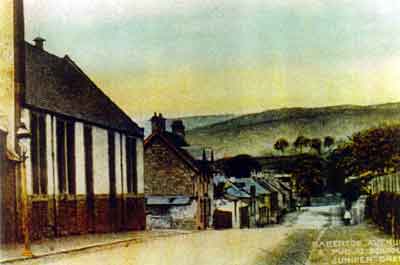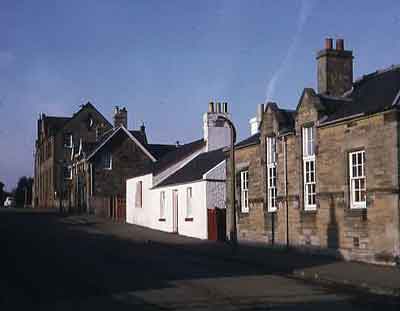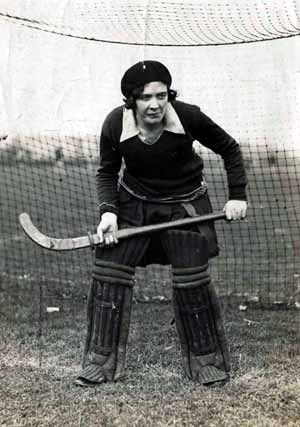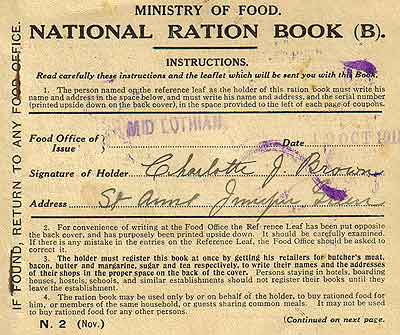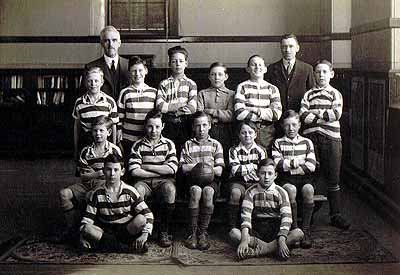EDUCATION in JUNIPER GREEN 1857 - 1957
The School Board takes over Juniper Green schools
The Education Act of 1872 made schooling to thirteen compulsory but not free. The management of the two Juniper Green schools was handed over to Colinton School Board in August 1874 and the slow process of enlargement and reorganisation began. The two parts of the school on Baberton Avenue (at number 28 and on the corner of what would become Woodhall Terrace some twenty years later) were re-organised as follows: all the under seven year olds attended the female school at 28 Baberton Avenue and the older children went up to the so-called male school further up the avenue. The girls had a choice: they could continue at 28 Baberton Avenue or if they did go on to the "male" school they had to return to the female school for sewing and knitting. The fees were 2 pence per week for a four year old child increasing to 3 pence per week for a seven year old. More details about the female or "wee" school can be found elsewhere on this website. The teacher's salary was £50 per annum.
The Free Kirk school becomes the "Male school"
The Juniper Green Male school roll increased to 85 pupils and the building was enlarged. Peter Malloch was recruited from Newcastle and appointed as headmaster in January 1876 beginning a father- and- son tradition that was to last 55 years. In 1883 a loan of £600 was taken out to erect walls enclosing the playground, to build toilets and some shelter sheds. By 1888 the roll had risen to 180 and in the following year fees were abolished.
Making schooling compulsory
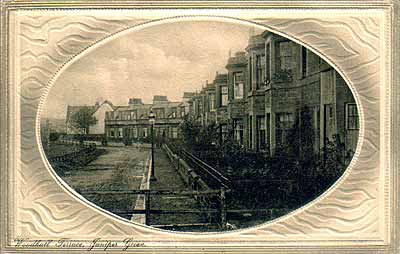
Juniper Green school before the upper storey was added in 1910 pictured here from Woodhall Terrace
The government was now investing heavily in education and consequently wished to regulate it. In 1894 pupils had to attain a leaving certificate before moving on from the school at the age of 14 years and schools had to be inspected annually. There were many requests for children to be allowed to leave school before their 14th birthday but these were rarely granted. A compulsory officer (an attendance or truanting officer) was appointed in 1897 at a salary of £35 per year to enforce attendance and many parents were brought before the school board to explain the absence of their child from school or their "verminous condition" in it. The occasional one was taken to court. During the 1880s and 1890s the school had to be closed most years for two or three weeks due to epidemics of measles or scarlet fever.
Classes became large with 214 pupils in 1894 but only the Head and two teachers with two assistants to manage them! By 1897 Peter Malloch the headmaster was earning £246 per annum but the other teachers were getting much less: David Scott £85 per year, May Davidson £80, Agnes Eccles £60, Margaret Macdonald £60, Marion Turner £40 and Christine Finlay (probably a pupil-teacher) only £20.
Improvements and expansions
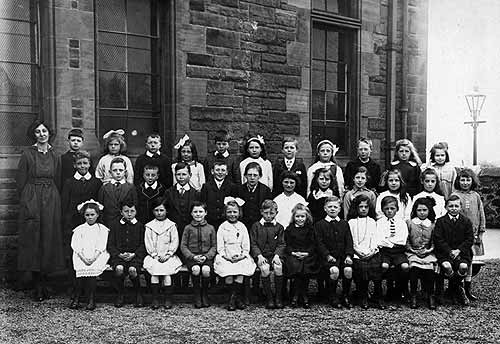
Outside the school during the First World War, notice the gaslight in the background
In 1897 the "wee" school was extended with the addition of a cloakroom. It now had two classrooms with an open fire. The Male school got gas lighting in the following year with two brackets and two hanging lights in each room. It became a Centre for Secondary Education and ambulance, woodcarving, dressmaking and dairy classes for adults were also held in the evenings.
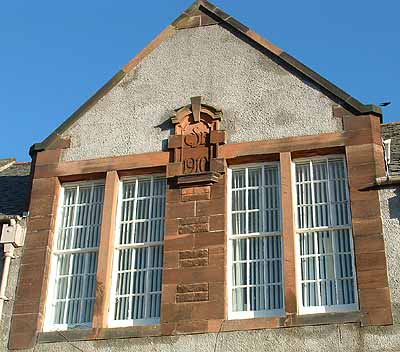
© Nutsend Productions
The upper storey window proclaims Colinton School Board's ownership of the new, enlarged Juniper Green School in 1910
Peter Malloch's son joined the staff in December 1898. Within nine months the father had resigned and James, the son, took over as Headteacher. The school continued to expand with a science laboratory in 1905 and an upper storey in 1910 for rooms for cookery and manual work. The school now became the Secondary School for the Water of Leith area covering Slateford to Balerno (1910).
A poor inspection
Despite the expansion the senior school was not doing well. It got a very poor inspection report in 1911 and the government grant was reduced by 20%. Only 17 of its Higher Grade pupils finished their course and a further 11 pupils did not make 80% attendance! Mr J J Malloch promised better things with the new extension and "additions to the staff". Graduate teachers of Science and Modern Languages were recruited to make a total complement of 12 staff.
Most staff were not local and used the train from Edinburgh. Since school started at 9.30am in 1912 the staff complained to the railway company that the 8.07am train from town was too early. They requested an 8.30am train to Juniper Green.
Early Health and Safety
In 1912 the pavement in Woodhall Terrace was tarred at the expense of the school board and the children were instructed on the "use of the road" as a result of increasing motor traffic.
As war loomed in 1913 the health of the nation was considered worthy of investment. A vaulting box, beams and jump stand were provided. The teaching of "Physical Exercise" was now also to be inspected. The school was presented with a cricket set and football for use in Bloomiehall Park.
Corporal punishment could only be given to a girl by a male teacher if a female teacher was present.
The First World War
The First World War brought some changes to school life. The infant pupils knitted "Comforts" for soldiers and sailors and the older children were given two weeks' holiday to help Mr Hunter with the potato harvest on Woodhall Farm. The children also gathered horse chestnuts which were sent by rail to the Ministry of Munitions for use as a propellant. There was concern about the dangers from the new-fangled airplanes and in May 1916 the board insured all the schools in the area against aerial bombardment for £20 and 2 shillings. From 1917 there was a food economy campaign. Senior boys handed out leaflets in the village and food demonstrations were given in the school. In June 1918 Ration Books were introduced and because of fuel economies the school day was shortened to 9.30am to 2.30pm.
Staffing during the War
A number of the staff were called up for military duties including the woodwork teacher, the compulsory officer, Alex Williamson, and the science teacher Mr Bain. Lieutenant Bain was killed in France in July 1916. There was a continuing difficulty in filling his post because male applicants had to have a certificate of exemption from war service. Those who had such a certificate could be very picky about job, salary and the accommodation. It was reported that accommodation was very hard to find in Juniper Green. Two women teachers who had married military men were (unusually) allowed to remain in post on marriage and a war bonus of £7 and 10 shillings was given to all staff. By the end of the war there were 237 pupils in the school.
Declining numbers
The Craik Report in 1918 suggested enlarging School Board areas to give a better salary structure and promotion for the staff. Juniper Green village was taken into Edinburgh, the "wee school" was closed in 1922 and the children all housed in the "big school". This was renamed the Higher Grade school.
No minutes or letter books could be found after the Great War so there is a gap in our knowledge, except for the occasional inspection report, until the logbooks of the 1950s. Juniper Green school lost its Higher Grade status in the early 1930s. Gradually, the secondary school children transferred to Edinburgh schools and the roll dropped to 134 in 1938 managed by 4 teachers. An inspection at that time commented that P2 was weak, P4 was "not a strong one" but that senior 1,2,and 3 were capably taught. Miss Black "loyally strove to maintain the reputation of the school for sound work". The roll continued to drop until after the war, in 1951, only 107 children were enrolled in a school deemed capable of holding 324.
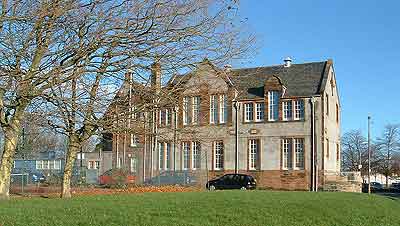
© Nutsend Productions
Juniper Green School on Woodhall Terrace
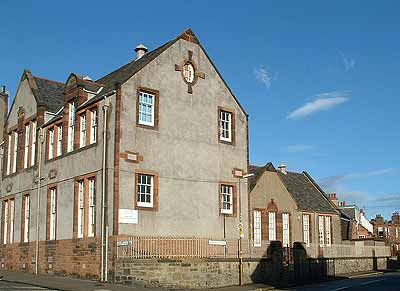
© Nutsend Productions
Juniper Green School on Woodhall Terrace
Several of our reminiscers (e.g. Mrs Marie Salton) have commented on their time at the school. These can be found elsewhere on this website. Typical of the remarks are the following by Sheila Hanson :
"I went to Juniper Green School when I was 5 years old. The Headteacher was Miss Spalding and the infant teacher Miss Mulholland. About 1949 Miss Spalding retired and we got Miss Nell Fraser who lived in Currie. Leaving Juniper Green you had to travel to Boroughmuir or Tynecastle depending on what sort of secondary course you wanted. I left Juniper Green school in June 1951."
References
Colinton School Board Letter books
Tweedie J A Water of Leith Walk
School Inspection Reports ED18/3186

